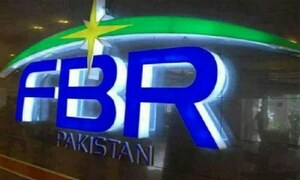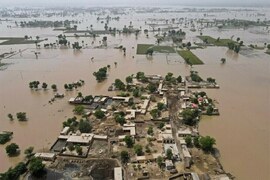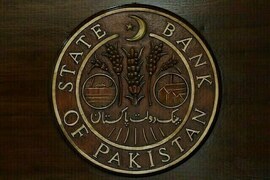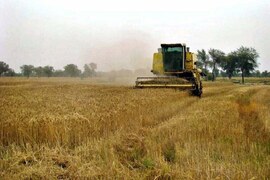The State Bank of Pakistan (SBP) has urged the government to speed up structural reforms in the fiscal and energy sectors in order to maintain the current growth momentum. According to SBP's first quarterly report on "The State of Pakistan's Economy" for FY14 issued here on Friday, the macroeconomic indicators are favourable at the start of the year and the increase in real GDP growth in initial months of FY14 is discernible.
The new government spelled out its policy focus on energy issues, which had suppressed growth in the previous few years. Estimates for growth exceeded expectations and GDP grew by 5.0 percent during Q1-FY14, compared to only 2.9 percent in Q1-FY13, and a target of 4.4 percent for the full year. Industry and services were the major drivers of growth, as agriculture performed below target, the report said
However, as FY14 proceeded, structural weaknesses in economy started taking a toll, and concerns started to emerge about the sustainability of economic recovery. "In our view, economic growth is likely to remain in the range of 3-4 percent during this fiscal, despite optimistic estimates for Q1-FY14, however there is need to further speed up structural reforms in the fiscal and energy sectors maintain the current growth momentum," it added.
The government has signalled, by focusing on these sectors, that its priorities are correct; however, the policies should aim to sustainably manage long-standing issues, instead of implementing makeshift arrangements, it said. "The IMF staff mission has recently concluded its meetings with Pakistan's fiscal and monetary authorities and the mission has found the macro stabilisation process in the energy and fiscal sectors to be on track," it added.
Similarly, the government is also implementing the National Energy Policy, which entails reducing end-user subsidies and improving bill collections. "Although it is too early to make any impact analysis on these efforts, however we believe the continuation of this reform process is critical for the long-term success of fiscal consolidation efforts," SBP said. In addition, several other factors had positioned the economy to post a recovery in Q1-FY14, including adoption of alternate fuel sources by industrial sector in past few years, initiation of talks for a new IMF programme, a single-digit headline inflation throughout FY13, and a 300 bps reduction in discount rate during FY13, which triggered some pick-up in manufacturing loans, besides reducing the government's debt servicing burden. The IMF is even more skeptical, and envisages a GDP growth of only 2.8 percent for FY14.
"We believe the industrial sector will continue its impressive performance for the rest of the year, but agriculture would remain subdued due to a decline in cotton production, and below-target sugarcane production," the report said. Within the services sector, some improvement is visible in telecommunications due to the better financial position of PTCL this year; and some increase in value-addition by wholesale and retail trade, following the rise in industrial production.
As far as finance and insurance is concerned, commercial bank profitability has declined in Q1-FY14, but the full-year performance will become clear once the banks finalise their year-end audited accounts, and provide conclusive figures for provisioning and recoveries, it added.
As the industrial sector revived, import pressures reappeared, especially for capital goods and raw materials. The import of petroleum, machinery, and metal, was particularly strong, which increased the trade deficit by $0.6 billion during Q1-FY14 over Q1-FY13. An additional stress on the current account came from delayed inflows of coalition support fund (CSF) in Q1-FY14. As a result, the current account posted a deficit of $1.2 billion in Q1-FY14, against a surplus of $0.4 billion in Q1-FY13. Although worker remittances posted an impressive 9.1 percent growth, this was not enough to cover the forex gap in other heads.
The report said that repayments on external debt continued to exceed fresh disbursements while foreign investments remained shy. This caused a strain on the country's forex reserves, which posted a decline of $1.2 billion during the quarter. As a result, the PKR depreciated by 6.0 percent against the US Dollar during Q1-FY14, compared to only 0.3 percent in the first quarter of the previous year.
The report pointed out that headline CPI inflation increased to 8.1 percent in Q1-FY14, compared to only 5.6 percent in the preceding quarter. SBP increased its policy rate by 50 bps to 9.5 percent in the monetary policy decision announced in September 2013 to rein in the second-round effect of food inflation, curb inflation expectations and to counter market sentiments following the volatile PKR.
According to the report, the government borrowing from the central bank was more pronounced, as commercial banks did not participate actively in T-bill auctions held during the quarter. As a result, the government could not meet the limit of zero quarterly borrowing from SBP, though its borrowings were well below the limit agreed with the IMF.
The fiscal deficit fell to 1.1 percent of GDP in Q1-FY14, from 1.2 percent in the corresponding quarter last year. This improvement occurred on both the revenue and expenditure sides. According to the report, there is a corresponding need to rebalance the maturity profile of Pakistan's domestic debt. The growing prominence of 3-month instruments in the outstanding volume of T-bills requires attention because this exposes the financial system to interest rate and roll-over risks.
BR100
15,235
Increased By
150.4 (1%)
BR30
44,824
Increased By
812 (1.85%)
KSE100
149,971
Increased By
1353.3 (0.91%)
KSE30
45,655
Increased By
407.2 (0.9%)






















Comments
Comments are closed.